The Data Science Playbook for Super Bowl Marketing
Key-Takeaways:
- Insights into the actions fans take digitally and physically can mold impactful strategies that will reach engaged consumers
- Some fanbases are more digitally engaged than others leading up to Sunday Night Football matchups, most noticeably Green Bay and New England.
- Team loyalty is a better indicator of digital fan engagement than predicted success in the Super Bowl.
- Some engaged fan bases are local to the team regions whereas some are more national
NFL Sunday Night Football
From September to February, football rules Sunday nights. So much so that NBC Sunday Night Football has been primetime’s #1 show for seven years in a row, with an audience of 19.7 million viewers.
While those nearly 20 million people tune in for the 3 hour game each week, the rise of digital content and streaming platforms means that the time spent watching a live game is only a small percentage of fan engagement. Engaged fans don’t hang up their jerseys after a game. They wear team colors day-in, day-out, 365 days a year. The way they engage with their favorite team extends beyond a live game and into the digital space. Final scores, game highlights, conference standings, draft rumors, etc are all available online.
Like any kind of consumer journey, how fans behave when they aren’t watching a live game can help build a more complete story of who the NFL audiences really are. The reality of digital engagement outside of live games gives power to regional targeting and opens opportunity for cross screen targeting with sponsorships and advertising efforts leading up to gameday. There are teams with national prominence and there are teams who’s engaged fanbase is uniquely local. Can we find the uniquely local fan bases based on digital behavioral signals?
NFL Fans by Region
We questioned why nearly 20 million people would tune into Sunday Night Football games. It could be out of team loyalty, a love football, or even a sense of ritual. Regardless of the reason, fans’ loyalty to the NFL is valuable to marketers. We asked, which cities would be the most captive audience for marketers to focus regional strategies leading up to a Sunday night football matchup? To answer this, we looked at which Designated Marketing Areas (DMAs) were relatively more engaged with the NFL during the each week’s Sunday night matchup.
Every day, Dstillery ingests 160+ billion data points from across the digital and physical worlds. We use these signals to dynamically score and automatically assign users into audience segments on a daily basis. This means that each of the Dstillery Audiences are snapshots of how people are behaving in real time. Dstillery has created an audience for each team in the NFL based on digital engagement with team-related content, as well as a general NFL fan audience.
But what is “engagement”? The truth is that “engage” is a catchall term. We’ll often use the word engage to define actions we see users take. This year, we turned our focus to a specific kind of engagement: digital engagement or those actions that users take online. When we build custom audiences, like NFL Fans, we consider the digital behaviors of that intended audience. Fans of the NFL read articles related to owners, coaches, and players. They watch full games and video highlights of exciting and pivotal games. We use the endpoints of these behaviors, their website visits, as inputs for our audience model. So when we say ‘engaged with NFL content’ it’s a shorthand for all the behaviors the audience captures.
Using this historical audience data, we looked at the digital engagement of NFL Fans in a team’s DMA in the few days leading up to and after that week’s Sunday night game. We then compared the engagement of NFL Fans in opposing teams’ DMAs.
We visualized the matchups between the final four teams this season to see which region had more digital interest in the NFL each week. For example, during week 3, when the Patriots played the Lions, NFL Fans in New England were more engaged than NFL Fans in Detroit. See below as the NFL fans living where the final four teams play go head-to-head in a battle of engagement. (Interested in the fan data from all 17 weeks? Check out the chart here).
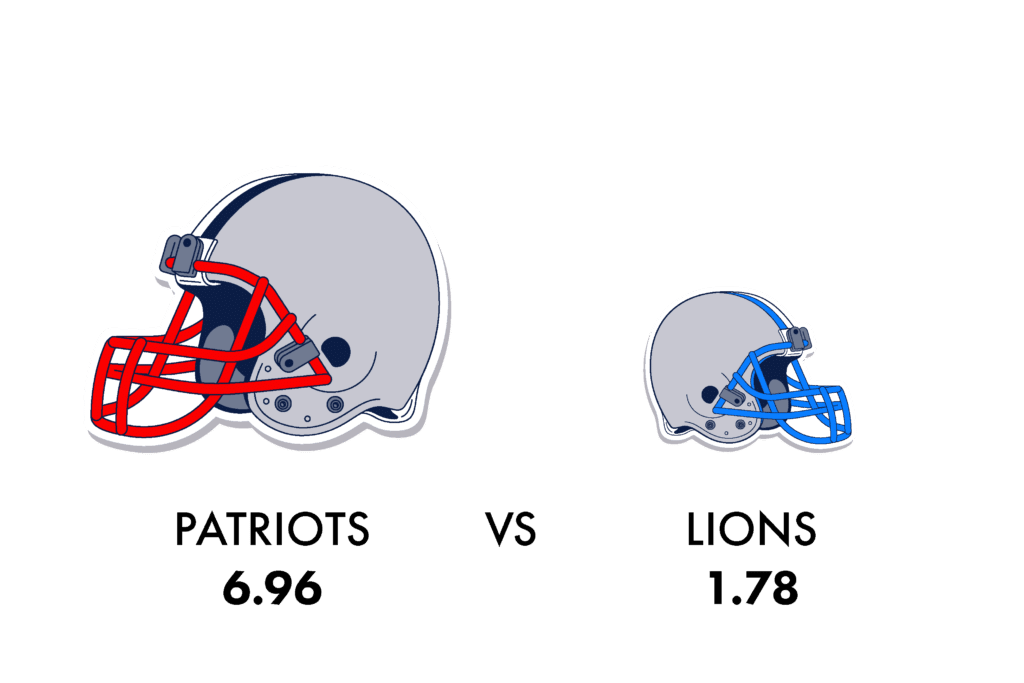
Week 3 
Week 6
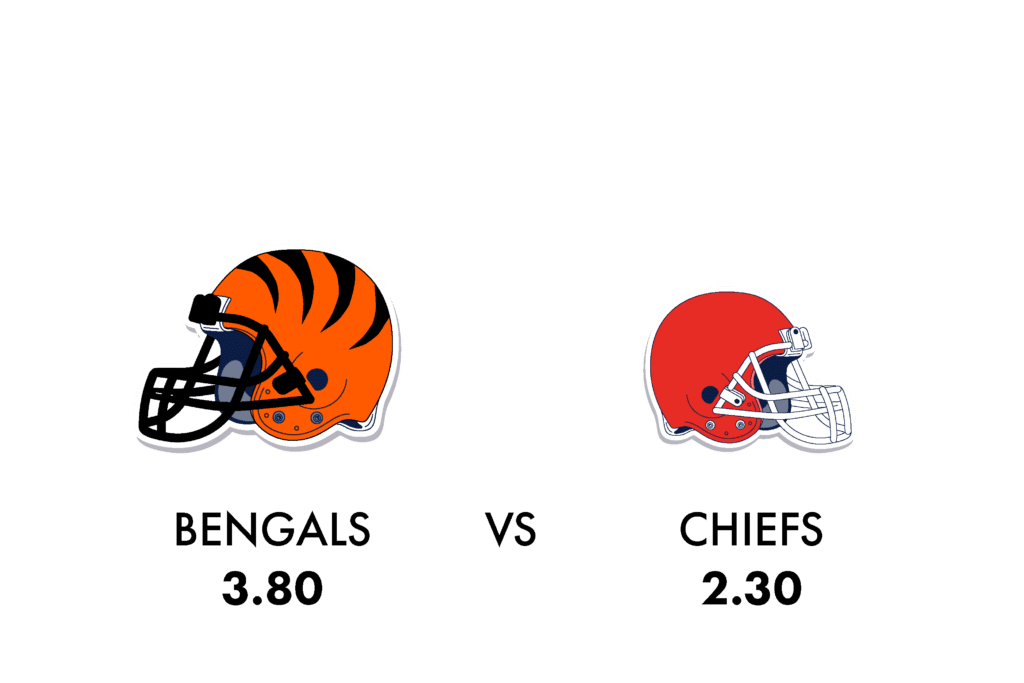
Week 7 
Week 8
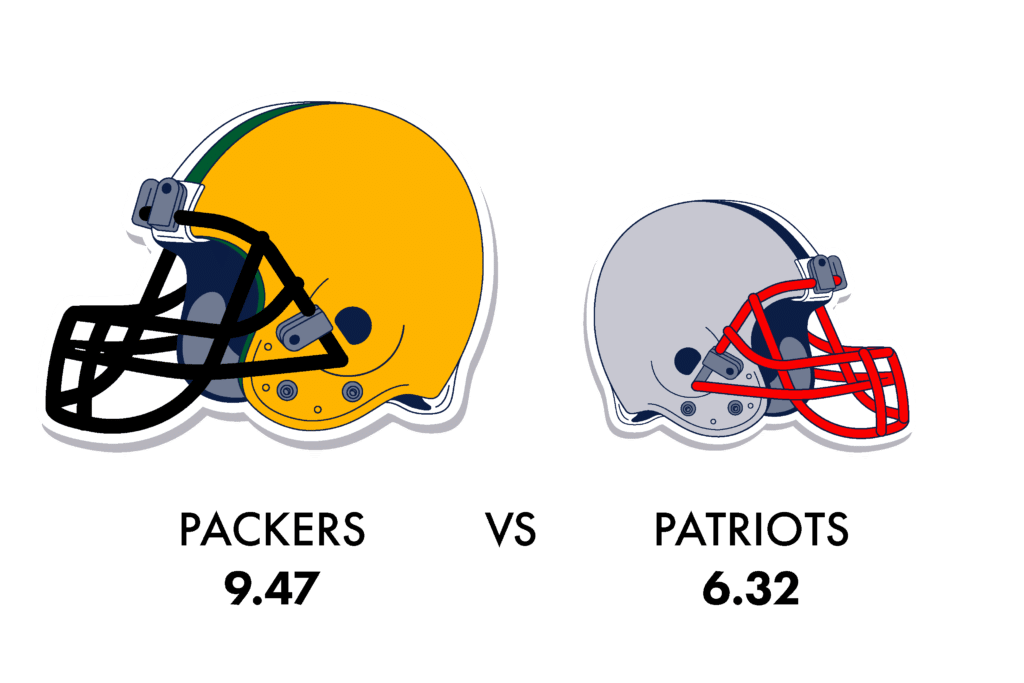
Week 9 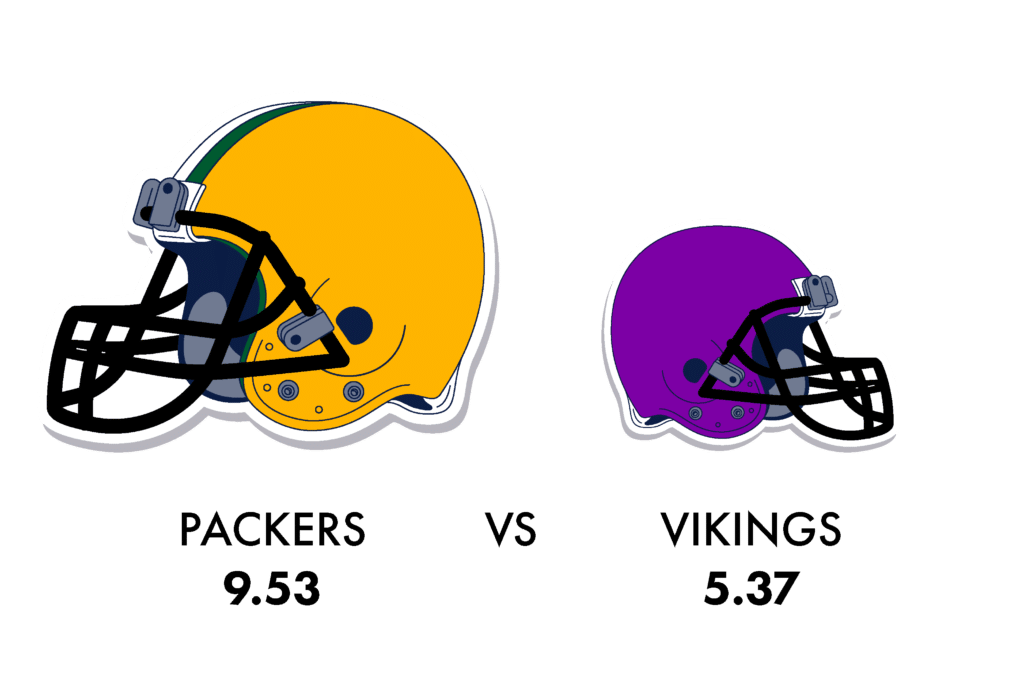
Week 12
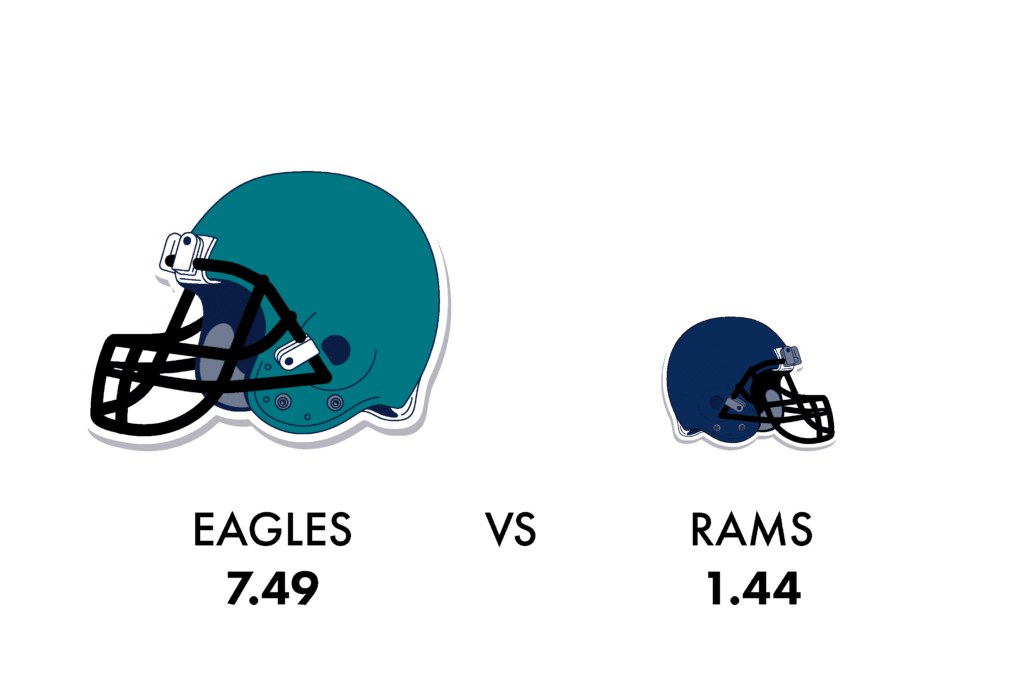
Week 15 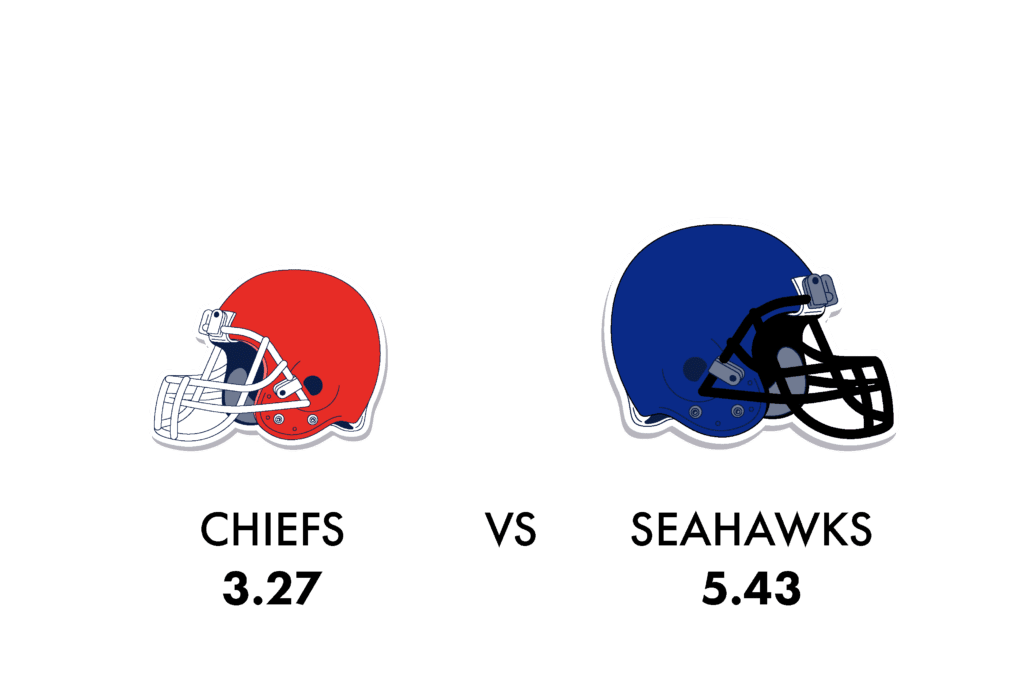
Week 16
Engagement indices of regions for Sunday Night Football matchups between the final four teams this season
Super Bowl LIII
As the culmination of a long, and often heartwrenching season, the Super Bowl draws millions of viewers, including those who don’t follow an NFL team. Diehard fans as well as those who join for the commercials and musical performances find themselves tuning in for the media spectacle. And while the total viewership (103.4 million people) was down for the 2018 Super Bowl, it was still the most watched television event of the year.
If you recall our Super Bowl analysis from 2016 and 2017, we looked to measure engagement during the live game – engagement in this context meaning attention. By looking at when viewers were using their mobile devices during the game, we could record when they’re not engaging with (watching) the live television content. You can read more about the study here.
In today’s digital world, engagement means more than watching the TV broadcast. Our 2016 and 2017 analysis is an example of how consumers have the luxury of splitting their attention between television and mobile screens. Streaming TV is something marketers have come to adopt. Whether live or streaming, engagement doesn’t stop at TV. The digital space opens up options for consumers. In the case of the NFL, fans may be replacing or, more likely, enhancing their viewing of games by purchasing merchandise, referencing trivia, and using apps to check scores while watching. These new consumption methods also open up options for marketers to reach consumers. Understanding the scale of consumption (whether uniquely local or broadly national) helps inform marketing strategies.
Engagement vs. Expectations
Our data has proven that regional fans are equally engaged during the first game of the season as they are on the last. We found that most teams had a strong local following of fans that were more uniquely engaged with their teams than other fans in the country. We also saw evidence of fan loyalty to teams that have migrated to new cities. Take fans of the Los Angeles Chargers: Moving from San Diego to Los Angeles hasn’t changed the Chargers fan base too much. Chargers fans are still more likely to live in the San Diego DMA than the Los Angeles DMA. Because users are assigned into team audiences regardless of geographical location in the US, we limited the variables of this analysis by focusing on fans who engage with team-specific content and live in the DMA where the team plays. Seahawks fans in the Seattle area, Cowboys fans in the Dallas area, etc.
We pulled local levels of engagement to test the potential of local vs national markets. Atlanta Falcons Fans in the Atlanta DMA maintain a level of engagement with the Falcons that is only 2.5x higher than the average user. Meaning, the engagement level of the local fanbase is similar to that of the nation’s overall engagement. Whereas, the Green Bay Packers Fans having 13x higher than average engagement index means that the local fanbase is much more engaged with the team than the national fanbase.
We then tested the relationship between an NFL team’s projected success and the level of unique local support. We used pre-season Las Vegas odds, as the proxy for predicted team success, and measured it against Dstillery’s custom audience data to get a view into the correlation between on-field success and the support of fans of the NFL teams. Based on the correlation between a team’s projected success and unique local support, can marketers build out more informed marketing strategies?
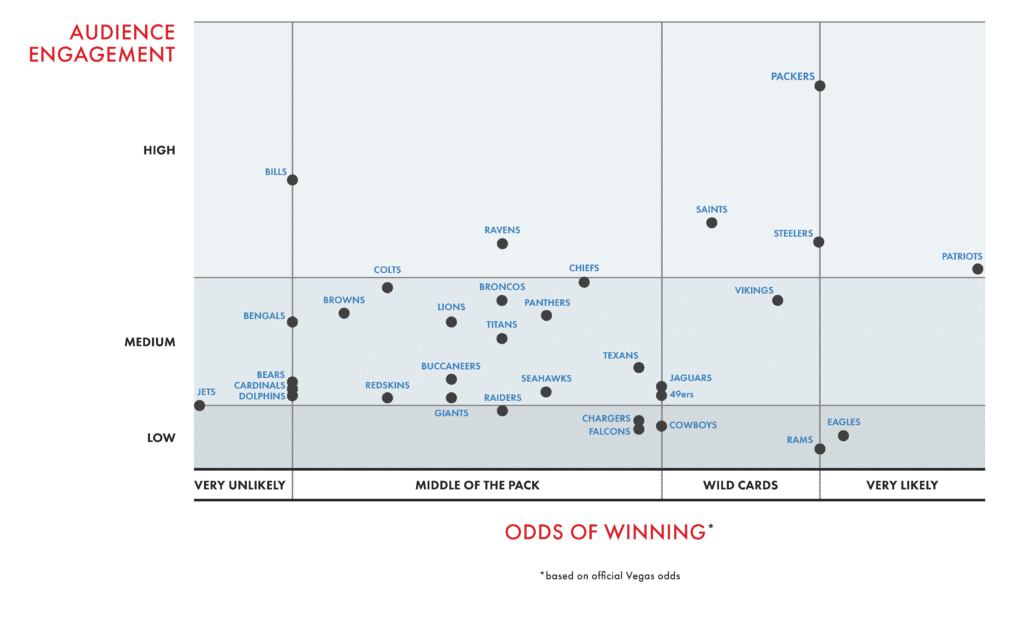
Audience engagement in this case describes how engaged that fanbase is with their local team relative to the country. For a lot of markets, the team’s likely success doesn’t dictate the level of unique engagement that the fanbase has for the local team. This can inform media targeting tactics for smaller markets, like Buffalo, because their fans are so uniquely loyal and engaged. Fans in Buffalo care about the their team to a greater extent than the nation cares about the Bills. The average value of these fans is higher on a per capita base, which could lead to more efficient digital ad spend when targeting fans in that market.
In response to this, consider ramping up digital sponsorships and leverage players as brand ambassadors. If you’re a marketer in Buffalo, you might find success in including the Bills in your next campaign. In contrast, low unique engagement could indicate that there is nothing inherently local about the fanbase and that engagement exists on a more national scale. With the nickname ‘America’s Team’ and a relatively lower engagement level, brand sponsorship may make more sense on a national level to reach Dallas Cowboy Fans.
If you’re a local Dallas brand, you may be wasting your marketing dollars on the Cowboys; when you sponsor them you are likely targeting fans nationwide. On the other hand, a local Buffalo brand would do well to use the Bills to get their message out despite the odds that their season may not stretch into the playoffs. A brand ready to expand more nationally could choose to sponsor a team with less unique local engagement in the low audience engagement category.
Spotlight on…
The Reigning Champs
Eagles — The relatively low unique digital engagement with Eagles content throughout this season could mean one of two things: 1) people who live in the Philadelphia DMA aren’t interested in the Eagles, or 2) the Eagles tend to have fans nationally. Eagles fans have a reputation for being over-the-top. We’d put money on the latter.
The Outliers
Packers — The Green Bay Packers Fans in the hometown area appreciate their team. They have the highest level of unique digital engagement out of all the NFL teams. Unique local engagement that high could be attributed to the concentration of Packers fans to the region or the availability of fan sites. For Green Bay Packers Fans, the top indexing website is www.CheeseheadTV.com.
Bills — The Buffalo Bills Fans in the Buffalo DMA are the second most likely fanbase to have high unique engagement with their team online despite having a rather low chance of reaching the Super Bowl. It’s hard to reason with a fanbase willing to wear zubaz and tailgate in freezing temperatures.
Jets — The Jets were predicted to have the lowest chance of reaching the Super Bowl this year. That didn’t stop New York Jets Fans from the New York DMA from having a higher level of unique digital engagement than the hometown fans of Super Bowl 53 contenders, the LA Rams.
The Runner Ups
Chiefs — The Chiefs broke out from the middle of the pack. They were predicted to be the least likely out of the final four teams to have a very successful season. The hometown Kansas City Chiefs Fans engagement this season is in line with Minnesota Vikings Fans in the Minneapolis region, who hosted the Super Bowl last year.
Saints — The Saints were predicted to do well this season. And Saints fans in the New Orleans DMA had high unique engagement; New Orleans Saints Fans were the third highest hometown fanbase to engage with their team, behind the Packers Fans and the Bills Fans. Saints fans are most likely to be golf enthusiasts (compared to other sports activities), so you may find them hitting the green instead of watching the game this year.
The Final Matchup
Rams — Los Angeles Rams in their hometown DMA of Los Angeles, a lot like the Philadelphia Eagles fans in Philadelphia, are not as likely to engage with their team online. For this fanbase it could be that there are more Rams fans outside of the Los Angeles area. People living in the St. Louis DMA and the Los Angeles DMA are neck and neck, with St. Louis barely winning out as the top ranking DMA for Los Angeles Ram Fans.
Patriots — The Patriots were predicted to be most likely to reach the Super Bowl. New England fans in the Boston DMA are among the fanbases most likely to engage online with content on their hometown team. If we look at New England Patriots Fans across the nation, they are definitely concentrated to the New England region; fans are most likely to live in DMAs across Massachusetts, Rhode Island, and Maine.
Post-Game Wrap Up
The Super Bowl is just one time of year for marketers to capitalize on those diehard, fairweather, and just-here-for-the-beer fans alike. Whether they’re watching the game or living their everyday lives, fans are a captive audience with impressive loyalty.
As our thoughts turn to whether or not the Patriots will bring home yet another ring, it’s important for brand marketers to recognize that insights into the actions fans take, both digitally and physically, can mold impactful strategies that will reach engaged consumers.


